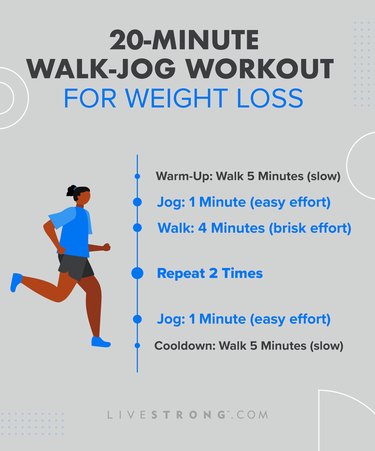

Convenient, accessible and effective — walking is a wonderful way to improve your fitness and lose weight (if that's your goal). But if you've been solely strolling for some time and want to up the ante, consider adding jogging intervals to your stride to increase the intensity and calorie burn.
And though a little light jogging ramps up the intensity, it won't put too much stress or strain on your body. Case in point: Researchers found that alternating between periods of walking and running reduced muscle pain and fatigue when compared to just running, per a January 2016 study in the Journal of Science and Medicine in Sport.
Video of the Day
Video of the Day
To get fitter, healthier and reach your weight-loss goals faster, try this 20-minute walk-jog workout by Janet Hamilton, CSCS, a clinical exercise physiologist and owner of Running Strong.
This basic blueprint may be modified based on your fitness level (more on this later) but it's a great place to start if you want to step up your stroll.

Tip
Pick a course that’s relatively flat. “Small short hills are OK, but you want to build strength on a more forgiving course before you throw hills into the mix,” Hamilton says.
Warm-Up
Start walking at a comfortable speed (you could easily chat with someone walking next to you) and gradually pick up the pace to raise your heart rate and prepare your muscles. Use the RPE scale to gauge how hard you're working. Do this for 5 minutes.
Jogging Intervals
Don't push too hard. Your jogging pace should be easy effort, i.e., not a sprint, Hamilton says. Slow and steady for the win. Do this for 1 minute.
Walking Intervals
You want the walk segments to help you recover and recharge for the next jogging interval, Hamilton says. Think a pace that allows you to catch your breath but that's still brisk enough to keep your heart pumping. Do this for 4 minutes and then repeat another round of a 1-minute jog followed by a 4-minute walk.
Cooldown
Take it easy and slow your stride (and heart rate). This last 4-minute walking interval will bring you right to the 20-minute mark.
Before you unlace, remember to do leg stretches for your quads, calves and hamstrings. Loose, limber limbs are less likely to become sore or injured.
When to Modify This Walk-Jog Workout
If you're new to running or exercise in general, you may find this interval walk-jog workout a little intense.
Always listen closely to your body. "You should finish feeling invigorated, not exhausted," Hamilton says.
Other signs you need to slow down: If you're experiencing stiffness, soreness, joint pain, excessive fatigue, sleep disruption or changes in appetite, you're doing too much too fast, Hamilton says.
In this case, it would be wise to begin with the basics. Spend several months just walking and gradually building up to a brisk pace that you can sustain for at least two continuous miles with no aches, pains or issues, Hamilton says.
Once you can walk comfortably at a brisk (but conversational) speed for at least 10 miles a week — injury-free — for two weeks, you can try transitioning to a walk-jog routine, Hamilton says.
How to Progress This Walk-Jog Workout
Looking for a bigger challenge? The best way to progress this walk-jog routine is slowly and incrementally. You want to make sure that your body can handle the increased workload.
"Tissue adaptation takes time — if you don't embrace that, you'll pay the price," Hamilton says. In other words, if you overestimate your fitness level and try to jump in with longer jog segments, you may get injured.
So how do you know when you're ready to take this walk-jog workout to the next level? If you're feeling energetic and injury-free after at least a week, you can extend the jog segments to 90 seconds while shortening the walking segments to three and a half minutes.
Then wait another week or so, and when you're able to do the 90-second jog segments well, you can progress to a 2-minute jog/3-minute walk routine. And so on and so forth, gradually adding 30-second increments to the jog intervals.
"The transitions seem ridiculously slow in the initial stages because we're trying to ensure you don't get injured," Hamilton says.
Remember: Even though you're running, this isn't a race. "It never hurts to be conservative and do less than you think you can — you won't hurt yourself by being conservative," she says. So be patient and pace yourself. Building strength, increasing endurance and achieving sustainable weight loss all take time.
Related Reading